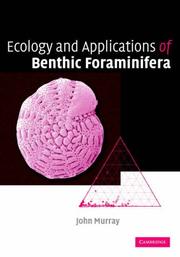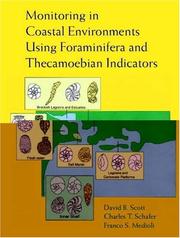| Listing 1 - 4 of 4 |
Sort by
|
Book
ISBN: 1623492130 9781623492137 9781623491956 1623491959 Year: 2015 Publisher: College Station, Texas : Texas A&M University Press,
Abstract | Keywords | Export | Availability | Bookmark
 Loading...
Loading...Choose an application
- Reference Manager
- EndNote
- RefWorks (Direct export to RefWorks)
In 1981, Woods Hole researcher C. Wylie Poag published the book Ecological Atlas of the Benthic Foraminifera of the Gulf of Mexico. In this new volume, Poag has revised and updated the atlas, incorporating three decades of extensive data collections from the open Gulf and from an additional seventeen estuarine systems to cover species of benthic foraminifera from more than eight thousand sample stations. Benthic Foraminifera of the Gulf of Mexico features 68 plates of scanning electron photomicrographs, 64 color figures, and a large color foldout map, indicating species distribution of forams.
Foraminifera, Fossil --- Paleoecology --- Foraminifera --- Protozoa, Fossil --- Palaeoecology --- Ecology --- Paleobiology --- Foraminiferea --- Foraminiferida --- Foraminifers --- Forams --- Thalamophora --- Rhizopoda --- Geographical distribution.

ISBN: 9780521070096 0521070090 9780511535529 9780521828390 9780511333958 0511333951 051153552X 1281040266 9781281040268 9780511335198 0511335199 0511333277 9780511333279 0511334613 9780511334610 0521828392 9781139130554 1139130552 1107160278 9786611040260 9781107160279 6611040269 Year: 2006 Publisher: Cambridge
Abstract | Keywords | Export | Availability | Bookmark
 Loading...
Loading...Choose an application
- Reference Manager
- EndNote
- RefWorks (Direct export to RefWorks)
In this 2006 volume John Murray investigates the ecological processes that control the distribution, abundance and species diversity of benthic foraminifera in environments ranging from marsh to the deepest ocean. To interpret the fossil record it is necessary to have an understanding of the ecology of modern foraminifera and the processes operating after death leading to burial and fossilisation. This book presents the ecological background required to explain how fossil forms are used in dating rocks and reconstructing past environmental features including changes of sea level. It demonstrates how living foraminifera can be used to monitor modern-day environmental change. Ecology and Applications of Benthic Foraminifera presents a comprehensive and global coverage of the subject using all the available literature. It is supported by a website hosting a large database of additional ecological information (www.cambridge.org/0521828392) and will form an important reference for academic researchers and graduate students in Earth and Environmental Sciences.
Foraminifera. --- Benthic animals. --- Benthal animals --- Benthic fauna --- Benthonic animals --- Bottom animals --- Bottom fauna --- Aquatic animals --- Benthos --- Foraminiferea --- Foraminiferida --- Foraminifers --- Forams --- Thalamophora --- Rhizopoda --- Foraminifera --- Benthic animals --- Benthos. --- Benthal organisms --- Benthic organisms --- Benthonic organisms --- Aquatic biology --- Aquatic organisms

ISBN: 9780511546020 9780521561730 9780521021142 0521561736 0511053517 9780511053511 9780511039690 0511039697 0511546025 1280429100 9781280429101 1107113180 9786610429103 0511174233 0511153929 051130224X 0521021146 Year: 2001 Publisher: Cambridge New York Cambridge University Press
Abstract | Keywords | Export | Availability | Bookmark
 Loading...
Loading...Choose an application
- Reference Manager
- EndNote
- RefWorks (Direct export to RefWorks)
Foraminifera and thecamoebians are highly sensitive to environmental stress (natural or anthropogenic). This feature means that they can be used to biologically characterize a variety of freshwater and coastal marine environments. Due to their small size and hard shells, large quantities are also found fossilised in core samples, making them ideal for reconstructing past environmental conditions. This volume covers the specific environmental applications of these organisms and contains an introduction to the subject, detailed descriptions of methods and techniques and case studies. Written for non-specialists, this book will appeal to resource managers and consultants in the public and private sector who routinely work on coastal environmental problems. The book will also serve as a supplementary text for graduate students in many courses on environmental monitoring, ecological baseline studies and environmental science.
Environmental monitoring. --- Coastal ecology. --- Foraminifera --- Testacida --- Testacea --- Thecamoebae --- Rhizopoda --- Foraminiferea --- Foraminiferida --- Foraminifers --- Forams --- Thalamophora --- Coast ecology --- Coastal zone ecology --- Coasts --- Coastal biology --- Ecology --- Sublittoral ecology --- Biomonitoring (Ecology) --- Ecological monitoring --- Environmental quality --- Monitoring, Environmental --- Applied ecology --- Environmental engineering --- Pollution --- Ecology. --- Measurement --- Monitoring
Book
ISBN: 4431543872 4431543880 Year: 2014 Publisher: Tokyo : Springer Japan : Imprint: Springer,
Abstract | Keywords | Export | Availability | Bookmark
 Loading...
Loading...Choose an application
- Reference Manager
- EndNote
- RefWorks (Direct export to RefWorks)
Foraminiferal cultures now serve as tools for researching biological, environmental, and geological topics. However, the biological backgrounds, in particular the natural histories of foraminifera, largely remain unclear. It is also true that the different techniques used in different subdisciplines are a setback to fully understanding the subject. Taken together, these factors prevent progress in experimental approaches to foraminiferal studies. This book aims to share and exchange knowledge between researchers from different subdisciplines, and the book should interest not only foraminiferal researchers but also scientists who are working with marine organisms to explore questions in relation to biology, geology, and oceanography.
Foraminifera -- Research. --- Foraminifera, Fossil. --- Foraminifera. --- Geology -- Methodology. --- Micropaleontology -- Methodology. --- Foraminifera --- Earth & Environmental Sciences --- Zoology --- Health & Biological Sciences --- Environmental Sciences --- Invertebrates & Protozoa --- Aquaculture industry --- Ecology. --- Environmental aspects. --- Foraminiferea --- Foraminiferida --- Foraminifers --- Forams --- Thalamophora --- Environment. --- Geobiology. --- Aquatic ecology. --- Environmental Monitoring/Analysis. --- Biogeosciences. --- Freshwater & Marine Ecology. --- Food industry and trade --- Rhizopoda --- Aquatic biology. --- Monitoring/Environmental Analysis. --- Hydrobiology --- Water biology --- Aquatic sciences --- Biology --- Environmental monitoring. --- Aquatic ecology . --- Biomonitoring (Ecology) --- Ecological monitoring --- Environmental quality --- Monitoring, Environmental --- Applied ecology --- Environmental engineering --- Pollution --- Aquatic biology --- Ecology --- Earth sciences --- Biosphere --- Measurement --- Monitoring
| Listing 1 - 4 of 4 |
Sort by
|

 Search
Search Feedback
Feedback About UniCat
About UniCat  Help
Help News
News